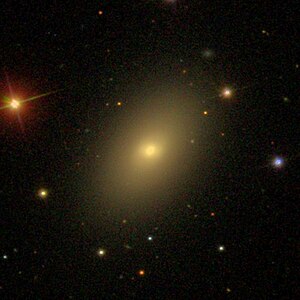NGC 2880
| Galaxie NGC 2880 | |
|---|---|
 | |
| SDSS-Aufnahme | |
| AladinLite | |
| Sternbild | Großer Bär |
| Position Äquinoktium: J2000.0, Epoche: J2000.0 | |
| Rektaszension | 09h 29m 35s[1] |
| Deklination | +62° 29′ 26″[1] |
| Erscheinungsbild | |
| Morphologischer Typ | SB0-[1] |
| Helligkeit (visuell) | 11,5 mag[2] |
| Helligkeit (B-Band) | 12,5 mag[2] |
| Winkelausdehnung | 2′ × 1,2′[2] |
| Positionswinkel | 140°[2] |
| Flächenhelligkeit | 12,5 mag/arcmin²[2] |
| Physikalische Daten | |
| Zugehörigkeit | NGC 2805-Gruppe LGG 173[1][3] |
| Rotverschiebung | 0.005184 ± 0.000017[1] |
| Radialgeschwindigkeit | (1554 ± 5) km/s[1] |
| Hubbledistanz H0 = 73 km/(s • Mpc) | (73 ± 5) · 106 Lj (22,4 ± 1,6) Mpc [1] |
| Durchmesser | 45.000 Lj[4] |
| Geschichte | |
| Entdeckung | William Herschel |
| Entdeckungsdatum | 2. April 1791 |
| Katalogbezeichnungen | |
| NGC 2880 • UGC 5051 • PGC 26939 • CGCG 312-011 • MCG +10-14-015 • 2MASX J09293461+6229262 • GC 1848 • H I 260 • h 596 • NSA 157278 • LDCE 635 NED004 | |
NGC 2880 ist eine elliptische Galaxie vom Hubble-Typ E/SB0 im Sternbild Großer Bär am Nordsternhimmel. Sie ist schätzungsweise 73 Millionen Lichtjahre von der Milchstraße entfernt und hat einen Durchmesser von etwa 40.000 Lj.
Gemeinsam mit NGC 2805, NGC 2814, NGC 2820 und IC 2458 bildet sie die NGC 2805-Gruppe (auch Holmberg 124).
Das Objekt wurde am 2. April 1791 von William Herschel entdeckt.[5]
Weblinks
Einzelnachweise
Auf dieser Seite verwendete Medien
Autor/Urheber: Sloan Digital Sky Survey, Lizenz: CC BY 4.0

Angle of view: 4' × 4' (0.3" per pixel), north is up.
Details on the image processing pipeline: https://www.sdss.org/dr14/imaging/jpg-images-on-skyserver/